Gary Engberg Outdoors
Spring River Walleye 101
The ice-fishing season was long in coming and is on is on final legs right now. But, the good news for anglers is that the walleyes and saugers are biting and have been for most of winter for those hardy soles that have never put their boats in storage.
Many fishermen put their boats away in the fall and don’t bring them out again until springtime when the ice and snow has left till the fall. But, there a growing group of anglers who have found out that the fish migration up river by walleyes doesn’t just happen one warm spring day. Walleyes start working their way up river in the fall and winter and travel as far as they can before encountering the first of many dams on the Wisconsin River at Prairie Du Sac. There are over 85 miles between the Mississippi River and the first dam on the Wisconsin. The important thing to take note of is that the walleyes and their cousin the sauger start migrating and looking for good staging spots and holding areas way before spring the hot spring bite. Even though their metabolism has slowed down considerably, river fish still have to eat everyday to just maintain their body weight. This river migration takes place in all rivers in the upper Midwest. The Mississippi, Fox, Wolf, Rock, Crawfish, St. Croix, and even the Pecatonica Rivers all experience this phenomenon.
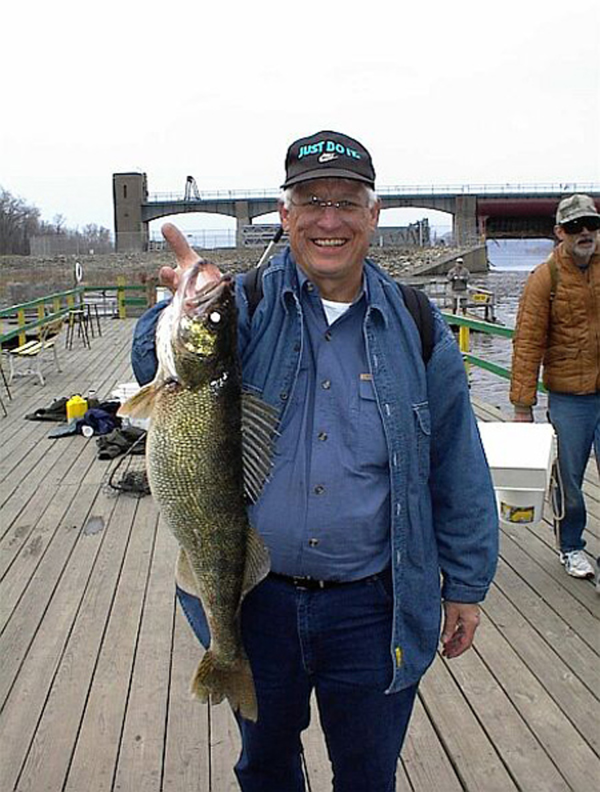
A happy angler at Clements Fishing Barge on the Mississippi River with a big walleye.
During normal winters, an angler can usually get out on a river by the end of February and for sure by the first two weeks of March. I’ve kept records over the years and there are always good walleyes caught by the end of February and some real trophies are caught the March and April. Though, the majority of the fish caught are small males, some large pre-spawn females are caught. This is one of the better times of the year to target big fish.
I know of some walleyes approaching 10 pounds that have been caught already this year. Anglers should remember that walleyes from the Prairie du Sac Dam west to the Mississippi River must be 18 inches to be legal while saugers are legal at 15 inches. The daily bag limit is 3 fish which can be a combination of both walleyes and saugers. Saugers stay at 15 inches, but are included in the 3 fish daily bag .The river above the dam (including Lake Wisconsin) will have a slot size where no fish between 20 and 28 inches can be kept.You may still keep 5 fish between 15 and 19.99 inches. Also, only one fish over 28 inches may be kept. These new regulations are in affect to the dam at Wisconsin Dells.
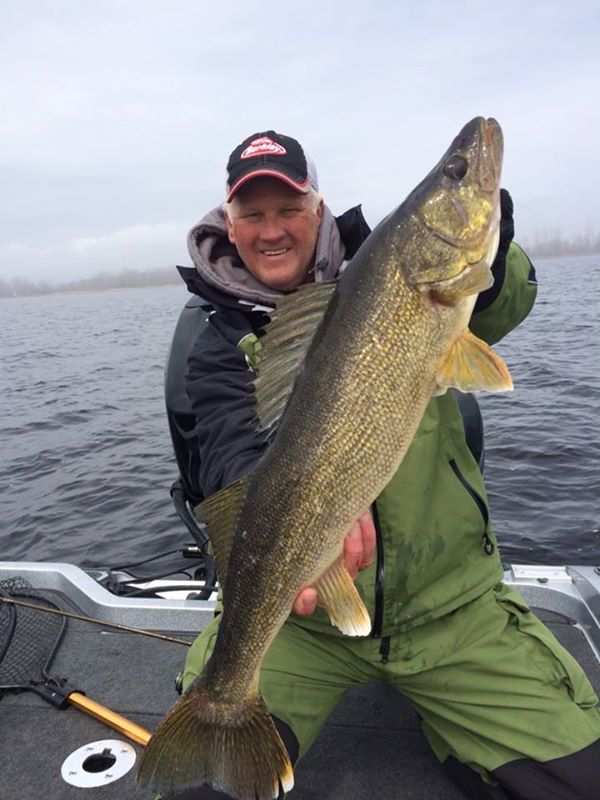
Bret Alexander with a big Fox River walleye.
If you fish the Wisconsin River and most others including the Mississippi, you have to use extreme caution because the rivers are low and your lower units and props can take a beating. I’d advise talking to someone, if these are unfamiliar waters, so that you have no major problems. You can use V- hull boats, but flat bottom johnboats are the best for most rivers.
Another way of fishing these early walleyes is to wade during low light periods of the day. You need a good pair of neoprene waders, about 4ml thick, to go into this 35-degree water. There are times when those wading do better than boat fishermen.You have to dress properly. Walleyes and often-big females will find areas out of the main current, where they can rest before they spawn and drop their eggs on the river’s marble size gravel and rock. Wading just before dark, at night, and just before sunrise are primetimes to catch river walleyes.
The best techniques for wading are casting a jig-minnow combo, a jig and twister tail, or a long stick bait like a Mann’s Loudmouth Jerk or a floating Rapala. The top colors are black/white and blue/white, though it still is important to experiment to see what the fish want that day.The same goes for jigs and plastic twister tails, change colors till you find the one that works that day. A rule I loosely follow is to use brighter colors during the day and black or white at night because then the fish are looking more at the profile and silhouette. Whether wading or fishing from a boat, one should work their baits extremely slow. Walleyes are still a little sluggish and won’t chase a jig or crankbait very far.
Two things; the rivers current and the available food supply drive river walleyes. Ideally, a walleye likes to hide behind something that breaks the current and wait for some food to float by and then dash out and get it. I mentioned it before, but it’s worth repeating. River walleyes have to eat everyday just to maintain their body’s weight. This is why walleyes like to position themselves behind something that breaks the current and allows them to conserve energy while waiting for food to float by.
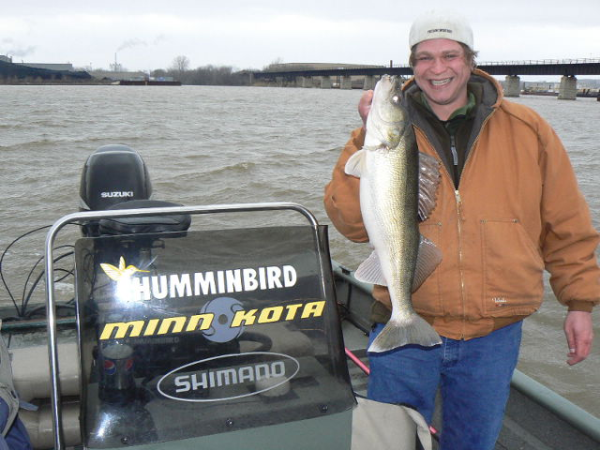
Guide Ron Barefield with another spring walleye.
Here are some of the areas to look for when fishing spring river walleyes. Remember that current breaks are the keys. Rocks, boulders, fallen timber, islands, bridge abutments, river bends, and wing dams are all good spring locations to search for fish. Feeder creeks and drainage culverts are other areas to consider. During periods of high water, walleyes will move into shallow spots of only a few feet to escape fast moving river currents. In low water times, the fish move deeper into the protected current areas.All these fish need is a rock to slide behind or a dip in the bottom of a foot or two to break the current. Conserving energy and finding food are what drives these river fish. Learning these basics will make anyone a better river angler.
Whenever you go to a dam area to fish you will usually find 90% of the boats concentrated in the main area below the dam. There’s no doubt that there are fish here, but not all fish go as far as the dam. Many fish will stage and find holding spots anywhere within a couple of miles of the dam. Experiment and get away from the crowds and you may be surprised at what you find. I live 4 miles below the Prairie dam and I catch big walleyes close to home all spring. The tailrace waters right below the dam are a place to start, but don’t get stuck by all the boats right below the dam.
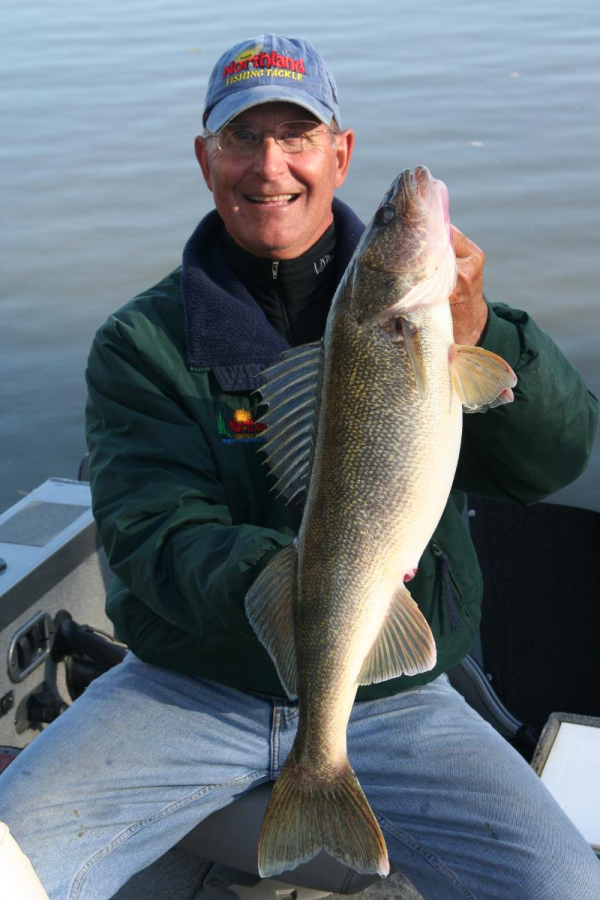
Dr. Sonar, Dr. Bruce Sampson with another nice walleye.
Spring river equipment is pretty basic; a good graphite rod about 6 feet long in medium or medium-light action (Loomis or Fenwick are great choices), a open face spinning reel with 3 or 4 ballbearings (Daiwa or Shimano), monofilament line in green or coffee color for the stained water (Stren or Berkley) in 6 or 8 pound test, and a good assortment of jigs from 1/16 to 1/4 ounce. Have 3 or 4 different color jigs in all sizes (the Bait Rigs Slo Poke is a great river jig) and plastic twister tails in assorted colors (purple, white, black, blue, chartreuse, orange, and glow ).I used to always use 6 pound test line, but I’ve switched to 8 pound which seems to work fine and I loose fewer jigs.
Cast your jigs and minnows and work them back slowly. The fish are going to be within a foot of the bottom, so use a jig that lets you maintain bottom contact. If you use too heavy of a jig, you’ll be snagged constantly. Also, somedays the fish want something simple like a plain hook and a split shot dressed with a fathead minnow. I may put a colored bead above the hook for added attraction or use a colored hook. Three-way swivels with live bait on a hook or a floating jighead works too and also helps you maintain your bottom contact. Lastly, use good, lively fathead minnows in a couple of sizes.
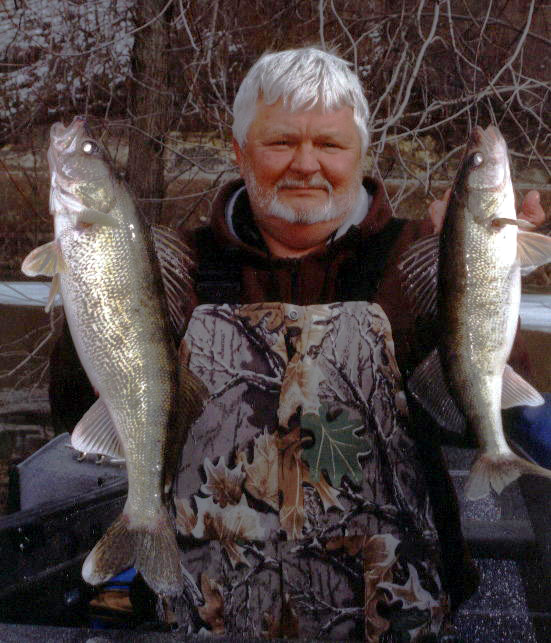
Bob Zownir with a nice river 'eye caught wading.
If you take some of my advice you should be able to catch some spring river walleyes and get a jump on the fishing season. Some good early places to fish are; Sauk Prairie and Wisconsin Dells on the Wisconsin River; Genoa and Ferryville on the Mississippi River; and Fort Atkinson and Jefferson on the Rock River. Good fishing!
Here are some good contacts. You may call or e-mail me, Gary Engberg, (608) 795-4208 or gengberg@chorus.net . Sauk Prairie, McFarlands True Value Hardware, (608)-643-3321 Saul City, Wi., Wisconsin Dells, River’s Edge Resort (608) 254-7707 ask for Botch. Petenwell Flowage, on the Wisconsin River Freeman’s Bait (715) 886-3541 ask for Jim. Mississippi River contacts; Dubuque The Bait Shack (319) 582-9395. Bellevue, Iowa Kiel’s Bait (319) 872-4258. Clinton, Iowa R and R Sports (319) 243-4696. Genoa Barge (608) 689-2800. Lacrosse, Wi. Bob’s Bait (608) 782-5552.











